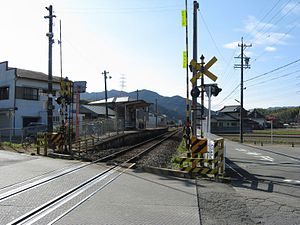네오플라보노이드
Neoflavonoid네오플라보노이드(Neoflavonoids)는 폴리페놀 화합물의 일종이다.[1] 플라보노이드(좁은 의미에서)는 2-페닐크롬-4-1 등뼈를 가지고 있는 반면, 네오플라보노이드에는 위치 2에 히드록실 그룹 대체가 없는 4-페닐크롬 등뼈가 있다.
종류들
네오플라보노이드에는 4아릴쿠마린(네오플라본), 4아릴크롬, 달베르기퀴놀 등이 있다.
- 네오플라본은[1] 4-페닐쿠마린(또는 4-아릴쿠마린) 백본(CHO15122)[2]에서 유래한다. 천연원에서 격리된 최초의 네오플라본은 칼로필름 인노필룸 씨앗(1951년)에서 추출한 칼로필롤라이드였다.[3] 스리랑카 토착식물인 메수아 트와이테이의 나무껍질과 목재에서도 발견되는 것으로 알려져 있다.[4]
- 네오플라벤은 4페닐크롬 등뼈(CHO15102)를 보유하고 있다. 달베르기아 시수의 줄기바크와 심재에서 추출한 달베리크롬은 그러한 화합물의[5] 예다.
기타 예
- 힌토니아 라티플로라에서[6] 발견된 쿠타레아제닌(5-하이드록시-7-메톡시-4-(3,4-디하이드록시페닐)-2H-벤조-1-피란-2-온)
- 달베긴
- 에치놉스 니베우스로부터[7] 격리된 니베틴
참조
- ^ a b Ollis, W. D. (1966). "The neoflavanoids, a new class of natural products". Experientia. 22 (12): 777–783. doi:10.1007/BF01897407. PMID 5973205.
- ^ Nishimura, S.; Taki, M.; Takaishi, S.; Iijima, Y.; Akiyama, T. (2000). "Structures of 4-aryl-coumarin (neoflavone) dimers isolated from Pistacia chinensis BUNGE and their estrogen-like activity" (PDF). Chemical & Pharmaceutical Bulletin. 48 (4): 505–8. doi:10.1248/cpb.48.505. PMID 10783069.
- ^ Garazd, M. M.; Garazd, Ya. L.; Khilya, V. P. (2003). "Neoflavones. 1. Natural Distribution and Spectral and Biological Properties". Chemistry of Natural Compounds. 39: 54–121. doi:10.1023/A:1024140915526.
- ^ Bandaranayake, Wickramasinghe M. (1975). "Xanthones and 4-phenylcoumarins of Mesua thwaitesii". Phytochemistry. 14: 265–269. doi:10.1016/0031-9422(75)85052-7.
- ^ Mukerjee, S.K. (1971). "Dalbergichromene". Tetrahedron. 27 (4): 799–803. doi:10.1016/S0040-4020(01)92474-3.[데드링크]
- ^ Korec, R.; Heinz Sensch, K.; Zoukas, T. (2000). "Effects of the neoflavonoid coutareagenin, one of the antidiabetic active substances of Hintonia latiflora, on streptozotocin-induced diabetes mellitus in rats". Arzneimittel-Forschung. 50 (2): 122–8. PMID 10719614.
- ^ Singh, R.P.; Pandey, V.B. (1990). "Nivetin, a neoflavonoid from Echinops niveus". Phytochemistry. 29 (2): 680–681. doi:10.1016/0031-9422(90)85148-9.[데드링크]
외부 링크
![]() Wiktionary의 네오플라보노이드 사전 정의
Wiktionary의 네오플라보노이드 사전 정의




